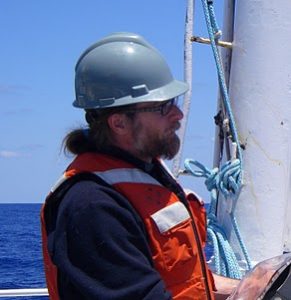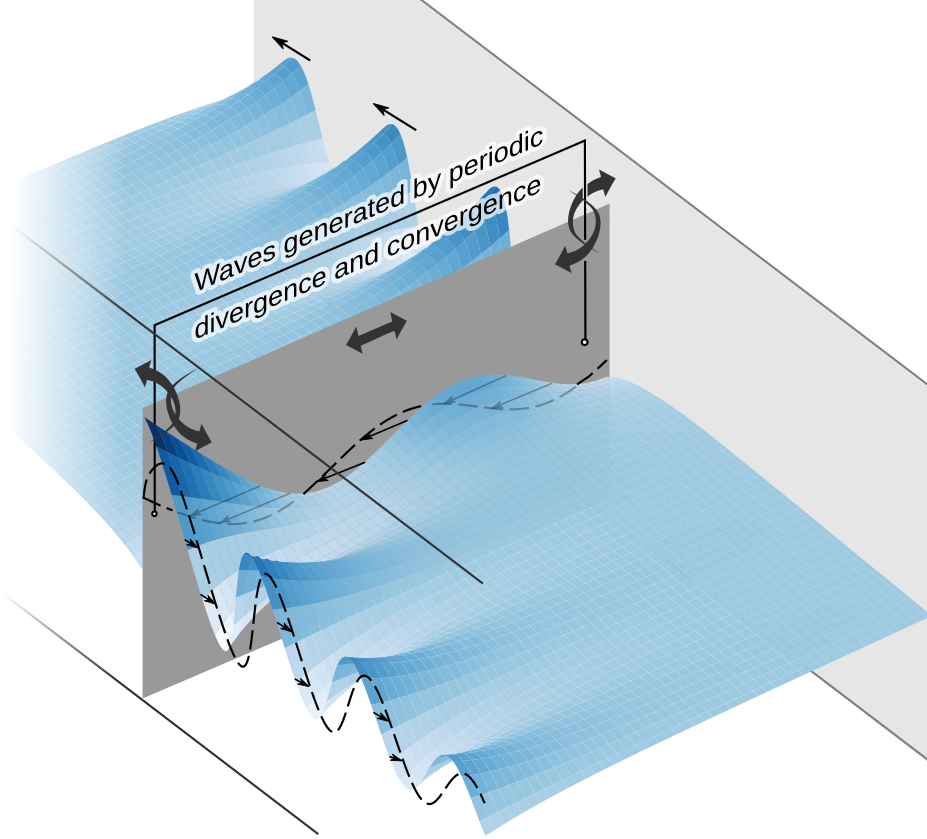story by Helen Hill [2] for MITgcm
Canadian researchers have been using the MITgcm in an idealized channel to investigate high-latitude tidal dynamics relevant to the fjords and channels of the Canadian Arctic Archipelago.
 [3]
[3]Kenneth Hughes is a Postdoctoral Research Scientist at Oregon State University interested in understanding the physics of smaller-scale processes “that ultimately influence larger-scale processes.” To achieve this, he combines numerical modeling with analysis of in situ observations. He has been using MITgcm since 2014. Check out his blog at https://brushingupscience.com/ [4]
In high-latitude fjords and channels such as those in the northernmost reaches of Canada, walls support radiating internal tides as Kelvin waves. Such waves allow for significant energy extraction from the surface tide, which otherwise should be small or negligible at such high latitudes because tidal waves are sub-inertial. Exploring rectangular channels of varying width featuring idealized, isolated ridges, Ken Hughes [5] (formerly of University of Victoria, Canada, now at Oregon State University) and Jody Klymak [6] (University of Victoria, Canada) have been investigating the fundamentally three-dimensional flow in a sub-inertial channel with a suite of MITgcm simulations. Their work was recently published in the Journal of Physical Oceanography.
The work was inspired by observations of radiating waves [7] made by Hughes and co-authors in a channel in the high Arctic as part of the Canadian Arctic GEOTRACES program. “This idealized study started as a test of what happened as I increased the width of my rectangular channel. A seemingly simple test, but one that produced a surprisingly complex resonance process,” explains Hughes. “Initially I thought I must have made a mistake since the results were not at all what I expected. Instead, the simulations demonstrate that a Kelvin-like wave propagates along the ridge in the center of the channel, and the phase of this wave controls how much energy is extracted from the barotropic tides.”
Writing up their findings in “Tidal Conversion and Dissipation at Steep Topography in a Channel Poleward of the Critical Latitude” [8] the authors report that even in channels as wide as five times the internal Rossby radius, tidal conversion can remain as high as an equivalent non-rotating system and that instead of varying monotonically, tidal conversion repeatedly increases and decreases as the channel widens, due to interference between the Kelvin waves along the wall and similar waves propagating along the ridge flanks (the wavelengths of which the authors were able to estimate from linear theory to guide prediction.)
 [9]
[9]Jody Klymak is a Professor at the University of Victoria, BC working on observing and parameterizing mixing processes in the ocean. He has been an MITgcm user since 2008.
Because the wavelengths are comparable to width scales of Arctic channels and fjords, the authors conclude that such interference will play a first-order role in tidal energy budgets and may consequently influence the stability of glaciers, the ventilation of deep layers, the locations of sediment deposition, and the fate of freshwater exiting the Arctic Ocean opening up a rich new vein of inquiry.
Isopycnal response to tidal forcing in a rectangular channel [10] – A 600km long rectangular channel containing fluid with a constant stratification of maximum depth 250m is forced by a subinertial M2 tide. The presence part way along the otherwise flat channel floor of a 200m high Gaussian ridge perpendicular to the tidal inflow generates along-ridge waves that interfere with the Kelvin waves on the boundary. Examining the simulated response to variations in geometry, Hughes and Klymak find that in a narrow channel the response is almost two-dimensional but that although for certain channel widths an along ridge wave and an out-going Kelvin wave occur, for other widths, the ridge-wave destructively interferes with the Kelvin wave. Simulation/ animation credit: K. Hughes
To find out more about this work contact Ken [11].
This Month’s Featured Publication
- Kenneth G. Hughes and Jody M. Klymak (2019), Tidal conversion and dissipation at steep topography in a channel poleward of the critical latitude [8], Journal of Physical Oceanography, doi: 10.1175/JPO-D-18-0132.1
Related Publication
Kenneth G. Hughes, Jody M. Klymak, William J. Williams, Humfrey Melling (2018), Tidally Modulated Internal Hydraulic Flow and Energetics in the Central Canadian Arctic Archipelago [7], JGR Oceans, doi: 10.1029/2018JC013770
Other New Publications this Month
Ivana Cerovečki, Andrew J. S. Meijers, Matthew R. Mazloff, Sarah T. Gille, Veronica M. Tamsitt, Paul R. Holland (2019), The effects of enhanced sea ice export from the Ross Sea on recent cooling and freshening of the Southeast Pacific [12], Journal of Climate, doi: 10.1175/JCLI-D-18-0205.1
Teresa K. Chereskin, Sarah T. Gille, Cesar B. Rocha, Dimitris Menemenlis, Marcello Passaro (2019), Characterizing the transition from balanced to unbalanced motions in the southern California Current [13], JGR Oceans, doi: 10.1029/2018JC014583
Evan B. Clark et al (2019), Station-Keeping Underwater Gliders Using a Predictive Ocean Circulation Model and Applications to SWOT Calibration and Validation [14], IEEE Journal of Oceanic Engineering, doi: 10.1109/JOE.2018.2886092
Clifton Dassuncao, Heidi Pickard, Marisa Pfohl, Andrea K. Tokranov, Miling Li, Bjarni Mikkelsen, Angela Slitt, and Elsie M. Sunderland (2019), Phospholipid Levels Predict the Tissue Distribution of Poly- and Perfluoroalkyl Substances in a Marine Mammal [15], Environmental Science and Technology Letters, doi: 10.1021/acs.estlett.9b00031
W. K. Dewar and J. C. McWilliams (2019), On Energy and Turbulent Mixing in the Thermocline [16], Journal of Advances in Modeling Earth Systems, doi: 10.1029/2018MS001502
Stephanie Dutkiewicz, Anna E. Hickman, Oliver Jahn, Stephanie Henson, Claudie Beaulieu & Erwan Monier (2019), Ocean colour signature of climate change [17], Nature Communications, doi: 10.1038/s41467-019-08457-x
Sotiria Georgiou, Carine G.van der Boog, Nils Brüggemann, Stefanie L.Ypma, Julie D. Pietrzak, Caroline A. Katsman (2019), On the interplay between downwelling, deep convection and mesoscale eddies in the Labrador Sea [18], Ocean Modelling, doi: 10.1016/j.ocemod.2019.02.004
Ganesh Gopalakrishnan, Ibrahim Hoteit, Bruce D. Cornuelle, Daniel L. Rudnick (2019), Comparison of 4DVAR and EnKF State Estimates and Forecasts in the Gulf of Mexico [19], Quarterly Journal of the Royal Meteorological Society, doi: 10.1002/qj.3493
Malte F Jansen and Louis-Philippe Nadeau (2019), A toy model for the response of the residual overturning circulation to surface warming [20], Journal of Physical Oceanography, doi: 10.1175/JPO-D-18-0187.1
Shumon Koga and Miroslav Krstic (2019), Arctic Sea Ice State Estimation From Thermodynamic PDE Model [21], https://arxiv.org/pdf/1901.10678.pdf
Leandro Ponsoni, François Massonnet, Thierry Fichefet, Matthieu Chevallier, and David Docquier (2019), On the timescales and length scales of the Arctic sea ice thickness anomalies: a study based on 14 reanalyses [22], The Cryosphere, doi: 10.5194/tc-13-521-2019
S. R. Pudjaprasetya and I. Magdalena (2019), Two-Layer Non-Hydrostatic Model for Generation and Propagation of Interfacial Waves [23], China Ocean Engineering, doi: 10.1007/s13344-019-0007-7
Charlotte C. Wagner, Helen M. Amos, Colin P. Thackray, Yanxu Zhang, Elizabeth W. Lundgren, Gael Forget, Carey L. Friedman, Noelle E. Selin, Rainer Lohmann, Elsie M. Sunderland (2019), A global 3‐D ocean model for polychlorinated biphenyls (PCBs): Benchmark compounds for understanding the impacts of global change on neutral persistent organic pollutants [24], Global Biogeochemical Cycles, doi: 10.1029/2018GB006018
Jieshuo Xie, George Krokos, Sarantis Sofianos, Ibrahim Hoteit (2019), Interannual variability of the exchange flow through the strait of Bab‐al‐Mandeb [25], Journal of Geophysical Research – Oceans, doi: 10.1029/2018JC014478
Do you have news about research using MITgcm? We are looking for contributions to these pages. If you have an interesting MITgcm project (ocean, atmosphere, sea-ice, physics, biology or otherwise) that you want to tell people about, get in touch. To make a post, contact Helen [26]
